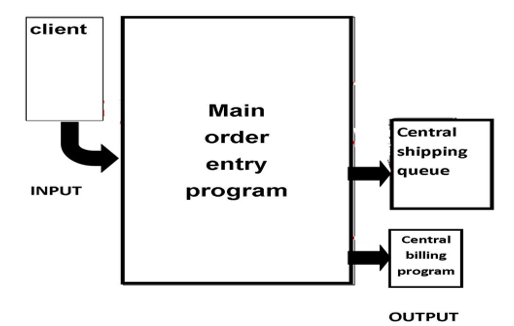General description
The General Purpose of the basic order entry system is to help support firms transact online, their clients to query items details in a catalog, order the item, and ship the item to customers. For a client to order the item, the ordering system confirms the database for the item, manipulates the inventory, and then forwards the request to the billing and shipping application (Gary and Harry 2008).
Users (or other information systems) and functions
- Client: He is the one to place an order to the system through the order entry interface (GUI.)
- Central queue program: It queues
- Central shipping program
Instance.
Snacy Ltd uses the ordering system, a shoe manufacturing company. It sells shoes to its customer in America.
External Description of the information system
Inputs
Client: Client input the detail of the shoe he wants to order form and his details from order entry GUI (graphical user interface), for both inventory checking and billing.
Output
Order entry program: check for shoe details in a local RDBMS.
Central queue: client order queues in the central queue for shipping.
Central shipping program
Central billing program
Information Processing
When a client places an order, the order entry GUI program calls the client program with an order placement request. The program identifies the transaction to run. The request from the GUI that was passed to the client program is directed to the CICS region, where it will be verified to check if the user is allowed to order. The user will not be allowed to continue if he is not qualified.
The customer information condition does more than a task. It processes the new task entities while still managing the older ones.
The CICS region begins the task, getting resources for the task; it runs the first program for the transaction that is the order entry program. Relation database entries are reduced by the main program. The RDBMS terminates any transaction from occurring in the database entry. CICS blocks the database. All the transactions made are seen but not do no reflect on the database. Until all the billing transactions are successfully processed and passed to the central billing program that is when the transacted process will reflect on the database. The billing program located in the CICS routes its request to the central billing station.
The central billing station is the mainframe remote program. The communication between the mainframe and the billing program is a peer to peer communication. The CICS billing program replies to the mainframe billing program. The shipping suggestion is passed immediately after database access by the order. That is when the CICS region commits and reflects the changes made to the database. This process makes the changes last for long. The application (simple ordering system) will be ready to serve another client after CICS has released the previous order entry, and the resources are not in use.
Information stored
Client information: Client full name, address and phone number, and credit card information are entered by the client into the order entry program.
Shipping information: shipping number, charges and shipping destination information is kept by the central shipping program.
Inventory information: shoe picture and name, shoe number and size, quality and quantity, and its brief description are kept by the RDBMS.
Billing information: Where payment can payment be made, explanation of financial responsibility and billing procedure explanation.
System boundary
Internal (inside) components
- Client program
- Local billing program
- Order entry GUI program
- Inventory program
- Main order entry program
- RDBMS (Relation database management system)
External (Outside) Components
- Client.
- Central shipping program (resource manager)
- Central billing program (mainframe server)
External view of the transaction processing system

An internal description of the transaction processing system
Information Processors
Order entry Program invokes the main order entry to perform its task.
Main order entry program: Ensues that all the RDBMS data is correct. It also queues shipping requests. The central billing program gets billing requests from the order entry program.
Local billing program: It’s the subprogram to the mainframe billing program, billing requests are passed through it to the central billing program. It provides feedback from the mainframe host to the main order entry.
Information stores
RDBMS: Simple order entry program has all its data in a central relational database system.
Networks
Company server: simple order entry application sends and receives its request in a peer-to-peer communication gateway server of the company.
Shipping: when an order is successfully passed the ordering procedures, the ordered shoe reaches the client through shipping to the client’s premises.
Internal view of information system

Additional notes
The introduction of this system has brought many benefits. Most importantly it has enabled any operations carried out on the system to be legal, and that is accepted. Also, it ensures that operations are either completed or successfully canceled.
Reference
Gary B. Shelly, Harry J. RosenblattReuter: system analysis and design (New York: The Author,): 57, 2010.
IBM. Concepts and planning: University of California, Berkeley, (2001):237.
Jim Gray, Andreas Reuter. “Transaction processing: concepts and techniques.” New York Times Book Review, 2003.